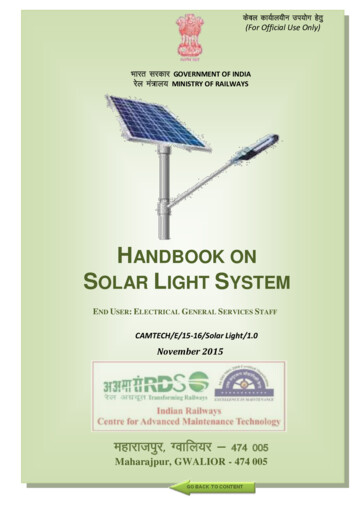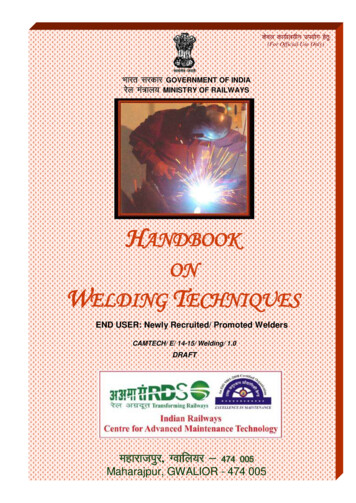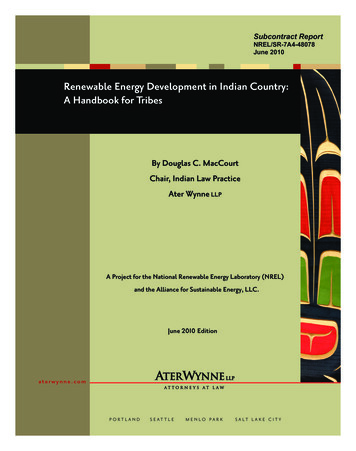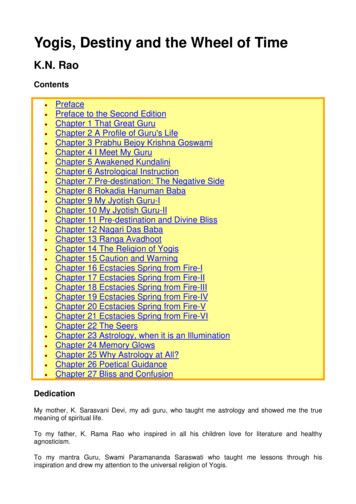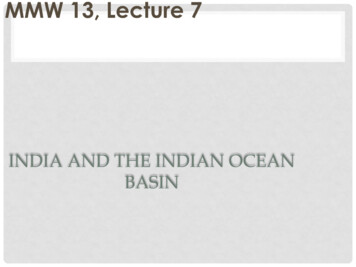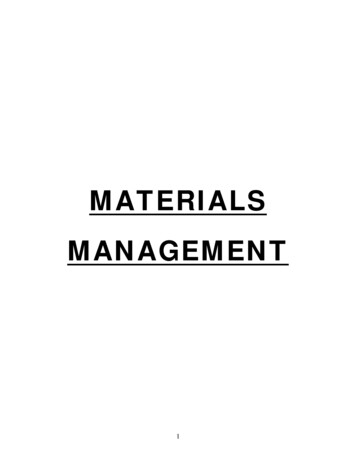
Transcription
MATERIALSMANAGEMENT1
ContentsSN.1234SubjectIntroductionClassification of storesStandard Nomenclature ListsRequisitioning and Distribution ofStoresPage chasingReceipt & Inspection of StoresReturned StoresSurplus StoresInventory ControlScrap Introduction to Supply ChainManagement38-4014Question Bank41-542
1.0Introduction1.1 General: For running any industry or business, we need a number of resources.These resources are popularly known as five M’s of any Industrial activity i.e. Men,Machines, Materials, Money and Management. All these resources, which are basicinputs, are important but their relative importance depends upon the particular type ofindustry and also other environmental factors. Earlier, when many modern machineswere not even known, whole activity was centered around one source, the men. Butnow the importance has by and large shifted from “men” to “machines” and in the recentenvironment, materials are the life blood of any industry or business and for their properrunning, materials should be available at proper time in proper quantity at proper place.Such compelling considerations have led to holistic management concepts like SupplyChain Management.1.2 Profitability: Basic goals of any industry are survival and earning profits to makeadequate returns on capital employed (Investment). The profitability of any organizationcan be judged by a ratio known as “Rate of Return on Investment”, which is defined asprofit earned per unit of investmenti.e. Rate of Return (ROR) ProfitCapital Employed (Investment)ROR Total Receipt (Revenue) – Total ExpenditureFixed Assets Current AssetsDifferent strategies for improving profitability (ROR) may be as under:(i)To increase total receipts: For this either sales have to be increased or theprices of the products sold have to be increased. Both these alternative are verydifficult to achieve in present competitive market.(ii)To reduce Expenditure: Majority of the expenditure of any industry is either onmen or materials. The relative expenditure on men and materials vary from industry toindustry but in most of the industries’ expenditure on materials is 45% to 70% of totalexpenditure. Therefore, two broad areas for reducing expenditure are men andmaterials. However, reducing expenditure on men is a very difficult task in today’senvironment of tight labour laws and strong trade unions. Therefore the other area tobe tackled remains reducing expenditure on materials. When we talk of expenditure onmaterials, it is relevant to point out here that there are two types of costs related tomaterials- “cost of materials” and “cost on materials” i.e. there is always some extraexpenditure related to materials which is not actual cost of materials. It needs to beappreciated that we can very well tackle these extra costs (cost on materials) without3
compromising the actual level of service (consumption) and achieve reduction inexpenditure.(iii) Reduce investment in fixed assets: As investment has already been made,there is very little scope for reducing expenditure on fixed assets.(iv) Reduce investment in Current Assets: Current assets consist of mainlyworking capital and inventory. As a rough estimate, about 40% of current assets aregenerally tied up in inventories of raw materials, consumables, materials under differentstages of production and finished goods. If we could reduce stocks of these differenttypes of inventories, we can very well reduce investments in current assets and improveprofitability.1.3 Functions of Materials Management Department(i)Planning: For materials there is invariably a need for planning. Apart from dayto-day activity a materials manager keeps a watch on the future activities of theorganization, which may call for specific items’ procurement in turn. Planning plays avery important role in assessing the quantity of the material, funds availability forpurchase/procurement and selecting the right source for supply.(ii)Procurement / Purchasing: Procurement of an item does not necessarily meanpurchasing. An item may be manufactured in the workshop or may be got transferredfrom another place as available. Alternatively, the item may be purchased from themarket. There are two basic types of purchasing in business world - Purchasing for resale and purchasing for manufacturing or consumption. In our organization we arebasically concerned with purchasing for manufacturing process or for consumption formaintenance and repair work.(iii) Warehousing (Store-keeping): To make materials available when required andto avoid stoppage of work, it becomes necessary to maintain adequate stocks of a largenumber of items. It involves a considerable amount of planning to decide the items to bestocked, the locations where these stocks are to be maintained, such as warehouses(stores depots), stacking arrangements and handling equipments etc. to be provided.The procedure for receipt, inspection, issue and accountal of materials and so on havealso to be in place. Proper methods of stocking and “preservation techniques” are to bethought of. In manufacturing organizations arrangements of warehousing are to bemade not only for raw materials, spares and consumables but for finished products andpartly processed materials as well.(iv)Inventory Control: To maintain stocks of materials at the correct level is a trickyproblem. For giving better services and to get price advantage it may be necessary tobuy in bulk (Economy of scale). But this may mean blocking of substantial amount ofmoney and the inventory carrying costs also go up. If we buy very frequently, cost ofordering goes up. In addition we may not get the quantity discounts. The risk ofmaterials not available when required and the consequent additional costs to the4
organization, have to be kept in view. Inventory control therefore, involves designingand following such policies, which will minimize sum total of various costs (the inventorycarrying cost and ordering costs) related to materials in an organisation. Inventorycontrol calls for right quantity, right quality, at right price from right source, at right place,at right time.(v)Surplus / Obsolete / Scrap Disposal: During the process of manufacturing,production, track renewals and gauge conversion etc. Railways generate largequantities of scrap, collection and disposal of which also is a big task.(vi) Distribution: Transportation and distribution of raw materials, spares,consumables as well as finished products is an important activity as it involvessubstantial costs. Efficient & responsive distribution system is very necessary for givinga good service. In the Railways, we are basically concerned with distribution of rawmaterials, spares and consumable, as the finished product is not in the material formbut in transportation service itself. Movement of material for Railway indenters may beby Road Transport, wagons, parcel vans, per bearer etc.(vii) Value analysis and cost reduction: Value analysis talks about value of an itemin use, in terms of primary function and cost of the material to achieve the function. It ispossible to keep the primary function of the product unchanged and reduce the cost ofthe material. Value of an item can also be increased by increasing the function andkeeping the cost as unchanged. Value analysis may be gainfully applied for high annualusage value items like “A” category items, further details of which are available insubsequent para.1.4 Objectives of Materials Management Department(i)Ascertaining the needs of various departments in the matter of Stores andmaterials.(ii)Preparing a correct estimate of the quantities of stores to be purchased ormanufactured in Railway workshops each year.(iii)Obtaining stores of the desired quality at competitive prices.(iv)Ensuring supply of stores in the required quantity in the most efficient,economical and expeditious manner.(v)Maintaining an economic level of investment in inventories.(vi)Receipt, inspection, stocking and distribution of stores to the variousconsuming points as and when required.(vii) Identifying and arranging disposal of scrap and other obsolete material withinthe shortest possible time to the best advantage of the Railway.(viii) Developing ancillary industries and indigenous sources of supply to replaceimports and(ix)Maintaining a constant touch with the market to ensure steady flow ofmaterial.1.5 Organisation of Stores Department: The Indian Railways net work is owned andmanaged by the Central Government. Operations are controlled and directed by the5
Railway Board under the over-all supervision of the Minister of Railways. The network ofRailways is divided into 17 zonal railways each under the control of a General Manager.Each Railway zone is organized on the divisional pattern of working.In addition there are modern Production Units- viz. Chittaranjan LocomotiveWorks, Chittaranjan (Electric Locomotives); Integral Coach Factory (Integratedcoaches), Chennai ; Diesel Locomotive Works (Diesel Locomotives), Varanasi; RailWheel Factory, Bengaluru; Diesel loco Modernisation Works, Patiala; Railway CoachFactory, Kapurthala.On a Zonal Railway, General Manager is assisted by Additional GeneralManagers and Heads of different departments such as Controller of Stores, ChiefEngineer, Chief Optg. Mgr., Chief Comml. Mgr., Chief Mech. Engineer, etc.1.5.1 Materials Management Organisation in Railway BoardMinister for RailwaysCRBMMAM(RS)EDs &Directors(Fig. I)In Railway Board, Member (Mechanical) looks after the materials managementfunction and Additional Member (Railway Stores) is the head of Railway StoresDirectorate.There are Executive Directors, Directors/Joint Directors and Deputy Directors inthis Directorate.The functions of Railway Stores Directorate in Railway Board are summarizedbelow:-6
(a)Policy Formulation: For efficient materials management on Railways, thedirectorate frames and issues policy guidelines to all Zonal Railways and productionunits on stores and purchase matters including coordinating various activities related tomaterials management.(b)Inventory Control: Railway Board evolve policies for efficient inventorymanagement of Indian Railways. For this, integrated materials budget is processed bythis Directorate. They also monitor inventory performance of Railways and productionunits by getting periodic returns from the Railways and issue directives from time totime.(c)Centralized Purchase: Railway Stores directorate also handles high valuepurchases. Some of the items are centralized for purchase through Railway Boardonly: Complete units of Rolling Stock, Wheel, Tyres & Axles (WTA) including Imports, Petroleum products including oils and lubricants (POL), Selected critical items for which manufacturing capacity is less than Railways’demands. These items are centralized for purchase through Railway Board toensure equitable distribution as per needs of Railways e.g. Composite brakeblocks, special steel and Processing of all cases initiated by Zonal Railways where the purchase is beyondthe competence of General Manager i.e. costing more than Rs. 50 crores peritem.(d)Liaison with other Ministries: Some of our purchases are being done throughDirectorate General of Supplies and Disposals. In cases of imports, sometimes we mayrequire clearance from Ministry of Industry and DGFT. To maintain good liaison withDGS&D and other Ministries, Railway Stores Directorate has posted one JA/SG Gradeofficer in Board who is designated as Railway Liaison Officer (RLO).(e)Coordination for supply of steel: For ensuring continuous supply of steel frommain producers to various Railways and production Units, Railway Stores Directoratehas posted one Director at Kolkata who coordinates with steel plants in drawing Rollingprogramme and monitors supply of steel to various Railways and Production Units.Director (Iron & Steel), Kolkata also plans and coordinates supply of steel to variouswagon builders.1.5.2Materials Management Organisation at the Zonal and Depot levelGeneral ManagerAdditional G.M.Controller of Stores7
CMMsDy. CMMs(Fig. II)The problems on Railways are more complex than those of a manufacturingorganisation as there are thousands of indenters spread over a large geographical area.The Railways, therefore, have to plan locations of various warehouses (Stores depots)with care. Normally, stores depots are located adjacent to major workshops and areknown as attached depots. In addition, stores depots for materials of general nature thatare required by most of the indenters are situated at one or more locations from wherethe supplies can be affected. These are called General Stores Depots.DY CMMSMMAMMAMMAMM(Fig. III)Stores Depots are generally under the supervision of gazetted officers of thestores department referred to as Depot officers. A Depot officer is responsible to theController of Stores for efficient maintenance of stock of stores and for prompt service tothe indenters in his territory. The depot officer is assisted in his work by Assistant DepotOfficers and other senior staff viz. Depot Material Superintendents (DMS).The work in a Stores depot consists of –1. Receipt and inspection of stores2. Storage and issue of materials3. Dispatch of materials4. Disposal of surplus stores and scrap materials.8
The depot is divided into different wards and sections for stocking different typesof materials and to deal with the work mentioned above.The purchase function is centralized in the Zonal Headquarters i.e. the office ofthe Controller of stores except for items of small value those can be directly purchasedby the executive officers and the depot officers. The Controller of Stores is assisted byChief Materials Managers (CMMs) and Dy. CMMs. Dy. CMMs are administrative incharge of different purchase sections as well as stores depots. The purchase sectionsare under the charge of purchase officers in different grades called Senior MaterialsManager and Assistant Materials Manager.The function of inventory control is basically a part of every stocking organisation.For evolving suitable policies and monitoring the progress a separate cell namedinventory control cell exists which functions in the headquarters under the Controller ofStores.1.5.3 Organization at Divisional levelDivisional Railway ManagerSr. DMM/DMM(Fig. IV)(a)Administrative and Technical Control of Sr. DMM/DMM: As with other branchofficers, the Divisional Materials Manager (DMM) works under the administrative controlof the DRM in respect of day-to-day working. For technical and procedural matters,DMM is directly responsible to COS and nominated CMM/Dy.CMM.(b)Duties of Divisional Materials Manager:(I)Ensuring availability of Materials: The Divisional Materials Manager shouldmonitor availability of imprest and non-imprest items, vital/safety/passenger amenityitems besides tickets, stationery and forms. He should also monitor expeditious receiptof non-stock items, requisitioned through him.(II)Ensuring economy in use of materials and making users aware of the needof such economy: With a view to controlling any wasteful and un-warranted9
consumption of material and also to keep the consumption of material within thebudgetary provisions, he should take adequate steps.(III) Review of sanctioned imprest: Regular inspection of the stocks available withimprest holders should be carried out by the Divisional Materials Manager to ensure thatthe imprest limits are realistic and are regularly reviewed/revised wherever necessary.The excess stocks should also be identified during such visits for further redistribution inthe Divisions and, if necessary, to other Divisions or for return to the feeding storesdepot.(IV) Local Purchase: It should be ensured that stores are purchased at reasonablerates and following precautionary measures are taken during local purchase of stores(i)(ii)(iii)(iv)Scrutiny of firms (Likely suppliers)Formation of approved list of suppliers, issue of bulletins etc.Local purchase as per the laid down procedurePhysical verification of material on its receipt, before it is ultimately handedover to the consumer.(V)Distribution of material from Stores Depots:(i)Monitoring and ensuring smooth movement of material within the division.(ii)Attending the Divisional Control Room from time to time to monitor themovement of material and sort out problems, if any by coordinating withconcerned branch officers.(iii)To plan, develop and head the Divisional Stores Depot to be created innear future.(iv)Transportation and distribution of materials by road transport within thedivisional jurisdiction.(v)Storage and distribution of direct delivery items.(vi)Identification of bulk items for storage within the Division for continuousavailability so as to improve service levels.(vii) Co-ordination with feeding depots for timely distribution of stock items toconsuming points.(VI)Scrap Generation and Disposal:(i)(ii)(iii)(iv)(v)Identification and monitoring of scrap disposal on the division with a viewto expedite the same.Assisting the Auction Conducting Officer in organising public auction fordisposal of scrap including proper security as well as arrangement forcollection of cash towards security deposits during auction.Monitoring progress of return of scrap to nominated depot.Disposal of low value items like waste paper, empty drums, etc.Coordinating deliveries of sold line scrap within the division and attendingto complaints and submission of completion reports.10
(vi)1.6Monitoring payment of Sales tax/Commercial tax, etc. to State Authoritiesby Sr.DENs on the scrap sold from the sites wherever such taxes arepayable.Stores DepotsFor facility of work, there should ordinarily be (i) A locomotive depot attached toserve the main Loco workshop (ii) C&W stores depot attached to C&W shops (iii) SignalStores Depot attached to Signal shops (iv) Electrical Stores Depot attached to Elect.Shops (v) P. Way depot for stocking P. Way & Bridge material (vi) Stationery depot (vii)Scrap yard (viii) General Stores Depot (ix) Electric Loco Stores Depot (x) Diesel LocoStores Depot (xi) Printing Stores depot attached to Railway Printing Press.2.0Classification of storesAll materials are basically divided into two broad categories viz. Stock and NonStock. The stock items are those items for which there is a regular demand, regulardrawl or consumption and there is a regular recoupment. Non-stock items are requiredoccasionally and not on regular basis. The Stores Department is required to give aservice of making thousands of items available to the indenters when required. Thereare approximately one lakh eighty thousand such items all over the Railways stocked in259 stores depots. To give this service we have to maintain stocks of a large number ofitems known as "Stock items" whereas for other items, which are not frequently requiredor having one time requirement, no stocks are maintained. These items are purchasedas and when required to meet specific demands and are called “Non-stock items”. Thestock items are classified further as under.2.1Ordinary Stores: These are generally such items of stores for which there is aregular turn over caused by a constant demand.2.2Emergency stores: The stores depots are also required to stock certain items ofstores even though they do not have a regular turn over. These are emergency storesand comprise of items which do not ordinarily wear out or require renewal but which arerequired to be kept in stock to meet emergency due to breakage or unanticipateddeterioration. These items are not readily available in the market and as such wouldrequire a long time for procurement in case they are not stocked.2.3Surplus Stores: Stores, which have not been issued to any user for past 24months or more, are classified as Surplus Stores. These are of two kinds- ‘Moveablesurplus’ and ‘Dead surplus’. Initially they are classified as Moveable surplus but if nouse is anticipated on any railway in coming 24 months the items are classified as DeadSurplus which are to be disposed off.2.4Special Stores: The items of stores required for works and other specialpurposes i.e. other than for ‘operation’ or ‘ordinary maintenance and repairs’ are called11
"Special Stores”. Generally such items are dispatched directly to the users without beingstocked in a stores depot.2.5Custody Stores: Stores which have been purchased for special works andcharged to such works but left in the custody of stores department are called custodystores. These stores chiefly consist of items obtained for the mechanical department forconstruction of rolling stock sanctioned under the capital or revenue programme.Directly the stores are received and paid for, the cost is at once debited to the worksconcerned. Instead of the stores lying in the workshops until they are required, thestores depot should keep them in safe custody, proper numerical records beingmaintained by it.2.6Inactive stores: Items which have no issues for last 12 months, and stocksexists are called inactive or non-moving items. It is left to the reader to think what willhappen if all items required by the railway are made as stock items or all the items aremade as non-stock items.2.7Imprest Stores: These items are required for day-to-day operation of servicesand maintenance of the activity. Imprest stores may be either charged off stores or maybe kept in capital account head also. Certain important units like loco sheds, TXRdepots etc. require a large number of items for day-to-day repeat use, maintenance andoperation of rolling stock, etc. Such items include consumable stores like cotton waste,oils, greases etc. as well as the spares required for rolling stock. The senior supervisorin-charge of the unit like running sheds, train examination depots; Chief SignalInspector, Electric Foreman etc. are allowed to maintain stocks of nominated items ofstores for this purpose. These stores are called imprest stores. The limits up to whichthe stocks are to be kept are also specified while sanctioning such items and aregenerally fixed as 2 or 3 months requirement. Imprest stores is like a standing advanceof materials to meet the day-to-day requirement of repairs, maintenance and operationof rolling stock etc. On most Railways the imprest stores are charged off to the finalhead of account under revenue working expenses. However, these units maintaindetailed accounts and monthly imprest schedules are sent by the imprest holders to thenominated stores depot for bringing their stocks to the sanctioned imprest levels. Thissystem of imprest stores is useful in ensuring continuous availability of items, which areimportant and regularly required for day-to-day maintenance and operation. In case ofnon-compliance of demand for imprest stores, it lapses whereas for ordinaryrequisitions, the demand is kept pending for compliance as and when the material isreceived.12
3.0Standard Nomenclature ListsThe details of all items having possible use on Indian Railways are contained inbooklets known as nomenclature lists. These books contain complete and unambiguousdescription of items, their code numbers (Known as Price List Numbers or PL Nos.),Specification or Drawing No., the unit of transaction and the depots on various Railwayswhere the item is stocked. These details are elaborated further as under:3.1Complete and unambiguous description: The description of each item shouldbe framed in such a way that it does not give rise to different interpretations. Theobjective behind is that the user should know what exactly he wants, the purchaseofficer should know what exactly is required to be purchased and the supplier in turnshould know what is to be supplied. Otherwise the same item could be stocked atdifferent places under different headings, e.g. washers being called as rings, washers,bushings, collects, grommets, spacers, etc.3.2Describing an item: The basic commodity method has been adopted indescribing an item. In this system the basic commodity precedes the detaileddescription of the item. For example " Ordinary toilet soap" would under the method bedescribed as "Soap, Toilet, Ordinary".The basic commodity is soap. The word "toilet" specifies the kind of thatcommodity and "ordinary" further qualifies the toilet variety. It the basic commoditymethod is not used, the different kinds of soaps will find themselves listed in differentplaces. In short the description should be arranged in the following order of precedence:1.2.3.4.The mention of the basic commodityThe general variance in kind, use, size or shapeThe particular kind or size.The specification/drawing.A few instances of how the items would have been described in these books are:Item descriptionBrass plated spirit levelTaper shank twist drillNomenclature bookLevel, Spirit, brass platedDrill, twist, taper shankOnce the items are properly described they would be arranged in their alphabeticalorder.3.3End use of items: In some books the purpose for which the item is used is alsoincorporated in the nomenclature list. For instance there are numerous grades oflubricating oils stocked and used for various purposes. This information is briefly13
mentioned in the nomenclature not as a part of the description but say in remarkscolumn - as this will greatly help the consumer.3.4Mention of makers name: The commercial brand or the proprietary make of theitem will be avoided in the description. Rather than make or commercial brand, we needto mention specification and drawing reference for clarity.3.5Specification or drawing: Reference to a standard specification or in itsabsence the Railways drawing if any will be mentioned against each description.Specification and drawing references are not only useful to suppliers, including Railwaymanufacturing shops but also assist the Stores department in the purchase as well asinspection of supplies.3.6The unit: It is desirable that for each item all transactions should be in one andthe same unit. This will avoid unnecessary references for clarifications and would alsofacilitate correct issues and receipts eliminating arithmetical errors in conversion fromone unit to another. Some of the unit codes have been indicated as under:01 Number, 02 Pair, 03 Set, 13 Kilogram, 14 Quintal, 15 MetricTonne, 22 Metre and so on.3.7Material Code (P.L. No.): In order to recognise every item distinctly, each itemappearing in the nomenclature book has been allotted a code number, which is alsoknown as Price List number. These numbers enable unique identification of stock itemsand as a result of extensive standardisation all over the Railways, easy exchange ofinformation on each item among the Railway Zones and Production Units is possible.While allotting these numbers, an opportunity has also been taken to group the items ina meaningful manner, so that group wise analysis of materials is also facilitated. Eachstock item will have a unique PL number.All stock items are having PL numbers but all PL numbers are not necessarily stockitems. Unified lists are common to all Railways and facilitate easy exchange ofinformation between the Railways. Disposal of Surplus Stores and CentralisedPurchase becomes easier. In addition to PL no., depot, Unit, Vendor, Consignee etc.are also codified.3.8Eight digit coding of PL numbers (Semi Significant System):**AMAIN GROUP**BSUB GROUP***CSERIAL No.*DCHECK-DIGITPart "A" consists of two digits representing the Main Group of stores to which an itembelongs.14
Part "B" consists of two digits representing Sub Group. Each Main group has beendivided into several sub groups. The sub grouping for most of the rolling stock groups ison the basis of major assemblies of which the item is a part e.g. brake fittings, underframe, engine block, etc.Part “C' consists of 3 digits and it is the Serial Number of the item. No significance isattached to this number.Part “D” is the last digit, which has a special significance with reference tocomputerisation. This is the Check Digit. This digit is unique to a given number and it isintended to check the integrity of the number. Whenever the Computer encounters acode number during processing, it calculates the check digit on the basis of Modulus 11and checks if the calculated digit tallies with the check digit shown in the documentpunched. If the two do not tally the voucher is rejected.4.0Requisitioning and Distribution of Stores4.1Placement of requisition: All issues from a Stores depot are made on writtenrequisitions on the prescribed form by the indenter. These should be signed by agazetted officer except imprest schedules. There are following types of forms in use:(1) Recoupment schedule for imprest stores (Form No. S -1830)(2) Combined requisition and issue note (Form No. S-1313)(3) Separate requisition form (Form No. S - 1302)4.2Points to be observed while placing requisition:(a)(b)(c)(d)(e)(f)(g)(h)It is very necessary that an indenter when he wants to indent materialsrefers to the standard nomenclature list and or list of Stock items toascertain if any of the stock items can possibly be used to serve hispurpose.Give correct code no.Give correct descriptionGive correct specification /drg. with latest amendments, if anyGive correct quantity in unit of accountal as shown in nomenclature list.Give correct Head of Account chargeableConfirm availability of funds (Duly noting the same in Liability register)and finance vetting wherever necessary.Give correct details of the consignee (who is to physically receive thematerial) and consignee code number.4.3Nominated depots: Booklet on guidelines to indenting departments, indicateitems nominated to a certain depot. The requisitions on receipt in the nominated depotare scrutinised and registered. In case a non-stock item is demanded, the depot after15
verifying should offer the nearest equivalent item that is stocked to the indent
the material. Value of an item can also be increased by increasing the function and keeping the cost as unchanged. Value analysis may be gainfully applied for high annual usage value items like “A” category items, further details of which are available in subsequent para. 1.4 Objec




